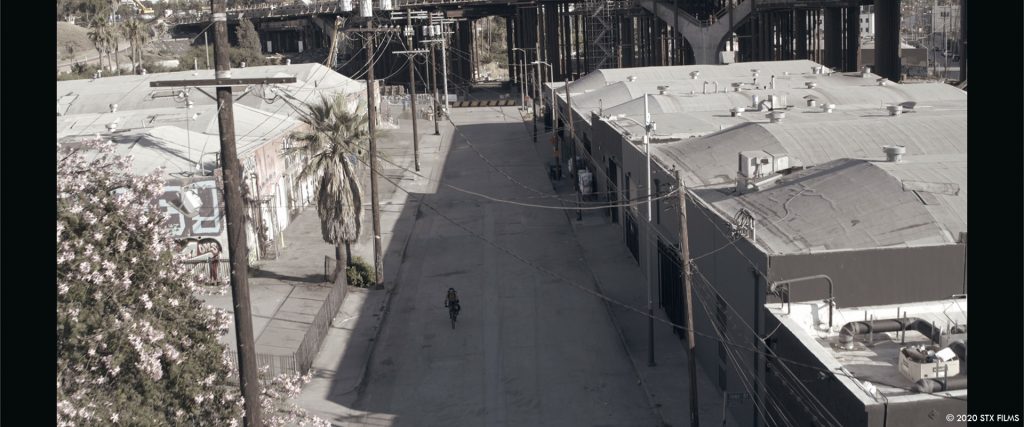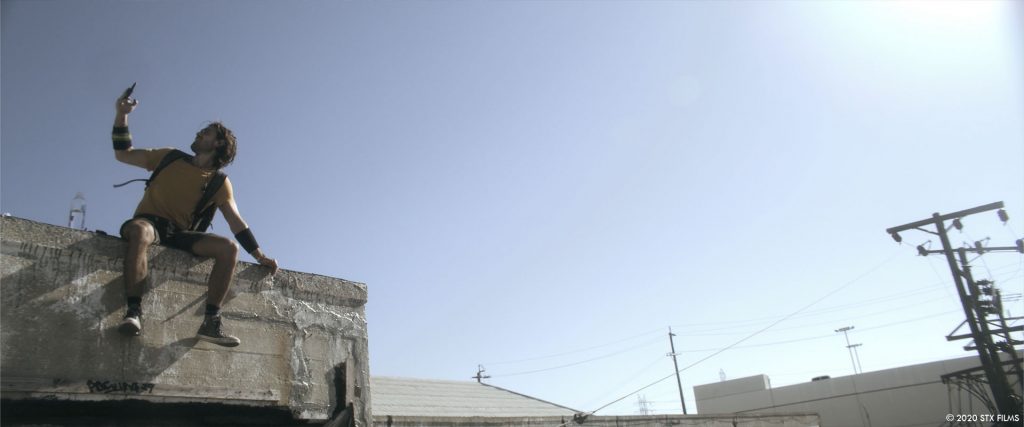In 2014, Dan Levitan told us about the work of Hammerhead on The Expendables 3 and then worked at Psyop and FuseFX on a various shows including War Dogs, The Last Man On Earth, Station 19 and Veronica Mars.
How did you get involved on this show?
I was referred to the Producers by an outside VFX Executive friend.
How was the collaboration with Director Adam Mason?
Amazing! Adam is a true collaborator and invited creative input. He was excited about what was possible in post and was willing to consider how best to shoot a scene in order to open up more VFX design options.
What were his expectations about the visual effects?
Adam wanted the VFX to match the documentary style of the film. Everything grounded in reality. We had several lengthy discussions about what Los Angeles might look like if municipalities had been shut down for 3-4 years. “LA in decay”.

How did you organize the work with your VFX Producer?
I was both VFX Supervisor and VFX Producer on Songbird, so there was a lot on my plate. Keeping things organized became a bit of a challenge in the last few months, but I had some help from my daughter, Angela, who also did some on-set assisting. I wanted to keep the work at one primary VFX vendor (Opsis VFX) with one additional back-up vendor (Ollin VFX). Due to Covid the crew had to remain very small and everyone wore multiple hats. Production-side VFX was basically a Department of one.
What was your approach for the devastated Los Angeles?
Keep it more about neglect than destruction. Abandonment – debris, grime, plant-overgrowth, active life and traffic removals. We studied what Los Angeles might look like after four years without basic maintenance. The Santa Monica Pier shot is a great example. There was also a secondary storyline about military presence locking down the city and controlling all movement. A large military presence would effect the look of the city as well.


Can you explain in detail about the Los Angeles environment work?
There were lots of subtle environmental modifications. Of course, as mentioned, lots of aging, adding grime, graffiti, damage, smoke plumes, etc. Lots of Matte Paintings and 2D elements mapped onto Geometry. There were also lots of CG Environmental Features added – The Wall (enclosing the Q-Zone and separating the city into regions), Lots of Barricades and Signage, Vehicles and Helicopters, Drone. We also had to find ways of incorporating our sponsors using CG Billboards and Product Placement.


How did you create the crowd for the Q zone?
Not sure how much I can reveal about that. Let’s just say, due to Covid restrictions, we had to get creative.
Which place was the most complicate to enhance and why?
The opening shot of the movie is a drone fly-over of the 101 Freeway at the iconic Hollywood Bowl offramp. The Director shot this himself and had a clear vision for it, but also asked for my creative input. There were many levels of VFX here, starting with removal of all traffic and active life. Then resurfacing the Bridge, Freeway, surrounding roadways and structures to add grime, cracks, and plant overgrowth. CG Barricades, Burned-out Cars, and quintessential ‘flock of birds’ (etc.) were added as well. In the end, around 60% of the scene is CG and very transparent, IMO.


Can you elaborates about the various helicopters and drones creation?
We submitted various logical helicopters model options given the circumstances for the Producers to review. Once they made their selections, I blocked the action and with previz from Opsis, we dialed in approved composition and animation.
“Max” (the Acting Drone) was a Physical Prop which was not safe to fly so I shot photogrammetry of the prop and Opsis created the asset. As with the Helicopters, I drove the initial blocking with previz from Opsis. The animation and composition approval process was pretty painless. I shot 360 HDRs of all scenes, so lighting came together rather quickly. The Opsis Team took VFX to final. Their strength with Previz and Tech-vis was critical.

The movie is full of screens and graphics. Can you explain in detail about their creation and animations?
Yes, the world of Songbird required LOTS of screen work. This was an area where costs could potentially get out of hand. I worked very closely with the Playback and Graphics Teams (in Prep and throughout principal photography) to max out how much work could be in-camera and not Post. Some of my earliest “on the box” contributions were creating screen graphics for playback to use on phones and laptops. Opsis created several motion graphic compositions used for May’s Live Stream, the Virus Check App, and more. All of the Chat-Bubble” work was handled by Ollin VFX in Mexico City.
How did Covid affects your work?
We began production fairly early on in the quarantine. In fact, we were the first feature production to be approved by the guilds and unions in Los Angeles. There were still a lot of unknowns about Covid, but we knew we had to take every possible precaution. We were being monitored routinely and testing was constant. Masks and other PPE was required at all times. We had Covid Coordinators to consult and enforce ordinances. I felt very safe, and made sure to keep several feet of open space around me at all times. This was a challenge on 100+ degree days (Fahrenheit).


How did you choose your various vendors?
I sent out bid packages to several VFX vendors with the exact same shot list. I was familiar with the Opsis founders and their reputation in Previz and Tech-viz. They were the first company to reach out to me and propose a plan to help our production with Concept and Tech-viz. Opsis bid the work along with everyone else, but they also suggested a more broad-scope way to assist me using their strengths and International Talent Pool. As I was completely on my own, their proposal appealed to me, leading to the assignment of some early tests, which they knocked out of the park! Opsis VFX turned out to be the perfect partner on Songbird!
Ollin VFX are a Mexico City based company which I had heard good reports on. After several Zoom meetings, I assigned them a small set of difficult clean-up shots. They nailed them in short order, leading to many more “911” awards. Ollin were great to work with and quickly became an invaluable addition to our combined VFX Team!


How did you split the work amongst these vendors?
Opsis and I collaborated on prep for all initial set-ups of World-Building, CG and DMP based shots, along with the Drone work. This project was challenging in that the scope of the work changed routinely throughout Post, which had a major impact on the Artistic staff size. Opsis’s ability to quickly expand and contract to accommodate work-load was essential. Each week we would discuss their shot volume and what new work was coming in. Those conversations drove how best to engage Ollin VFX.
Can you tell us more about your collaboration with their VFX Supervisors?
Michael Jackson was the VFX Sup at Opsis and my primary point person. We, along with Lena Bahrs (Opsis VFX Prod) and Siena Elliot (Opsis VFX Coord) had multiple Zoom meetings per day to discuss status, budget, etc. We had virtual reviews in Shotgun twice daily. It went surprisingly well.
With Ollin, I coordinated mostly with Armando Ricalde, their General Manager and VFX Producer. They submitted their shots through FilmIO, which our Production had been using for dailies. It was quite easy to review, note and approve their shots in FrameIO.

Did you want to reveal any other invisible effects?
Some VFX contributions which I feel most viewers won’t even notice (as VFX) are the Military Barricades and Signs. Based off of Nico’s Bicycle and Motorcycle maneuvering we added dozens of CG Concrete K-Rail Barricades and Warning Signs. They were designed and positioned specifically to help further a sense of Trapped Claustrophobia along with intensifying Nico’s riding action.
Was there something specific that gives you some really short nights?
The biggest challenge on Songbird was quickly adjusting to changes in scope and budget. We started out with a micro VFX budget. In other words, the original budget was meant to cover 10-20 shots. Thus, an Artistic crew was hired based on that small scope of work. Throughout our tight post schedule the size and scope of the VFX increased exponentially. There were almost no weekends off and many sleepless nights on the final months of post.
What is your favorite shot or sequence?
Well, I’ll give you a few that stand-out to me. I love the Santa Monica Pier shot. This was one of the shots that Michael Bay and the other Execs really focused on. They wanted it to match the tone of the opening freeway shot. Opsis Artist, Johnny Banta, really killed it on this one! I also feel the opening Freeway shot successfully establishes the world we’re in right from the get-go. I am also very proud of the Story-Enhancing CG Barricades and Signage additions. IMO, they are absolutely transparent as VFX. They integrate extremely well and blend with the action as if planned before shooting, which was not the case.


What is your best memory on this show?
I felt very fortunate to have the chance to work with this amazing crew, Production and Post! These are difficult times and to be able to focus on what you enjoy doing was a welcome distraction. To be able to collaborate with such talented and remarkable people during this dark time was surreal and I will never forget it. I want to give special thanks to our Director, Adam Mason. What a fantastic leader and ally. I truly hope to be able to work with him again. Producer Jason Clark hired me on Songbird and took me under his wing (pun intended). I learned a lot from him and really respect his passion and drive. Adam Goodman and everyone at Invisible Narratives were great to work with as well. The Teams at Opsis and Ollin made this a lot of fun and very rewarding. This was my first experience working with Michael Bay and I definitely learned a lot from him as well.
These are not “normal” times and this was not an easy project by any stretch, but the team on Songbird powered through as Absolute Professionals with incredible drive and positivity. I am proud to have been along side them.
How long have you worked on this show?
Around 6 months total.
What’s the VFX shots count?
Approximately 300.
What was the size of your team?
As we constantly adjusted our international remote team, it’s difficult to say.
What is your next project?
Unfortunately, due to NDA restrictions, I am not at liberty to say. Stand by!
A big thanks for your time.
// Songbird – VFX Breakdown
Want to know more?
Dan Levitan: Official website of Overall VFX Supervisor Dan Levitan.
© Vincent Frei – The Art of VFX – 2021




